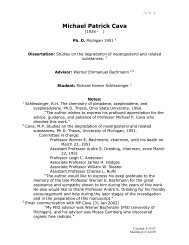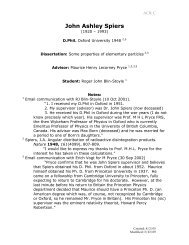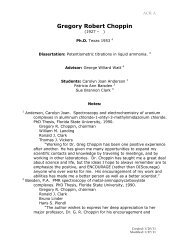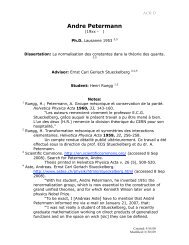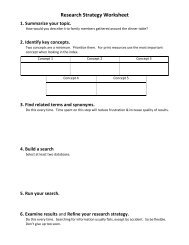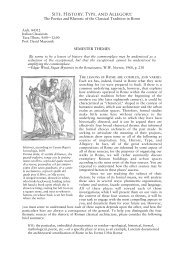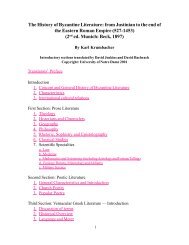Audio Video Metadata Best Practices (PDF) - University of Notre ...
Audio Video Metadata Best Practices (PDF) - University of Notre ...
Audio Video Metadata Best Practices (PDF) - University of Notre ...
Create successful ePaper yourself
Turn your PDF publications into a flip-book with our unique Google optimized e-Paper software.
Title: Creator: <strong>Audio</strong> <strong>Video</strong> <strong>Metadata</strong> <strong>Best</strong> <strong>Practices</strong>, <strong>University</strong> <strong>of</strong> <strong>Notre</strong> Dame, Hesburgh Libraries Digital Standards Team Alexander Papson, <strong>Metadata</strong> and Digital Services Librarian, (Chair) Julie Arnott, Manager, Preservation Tracy Bergstrom, Interim Co-‐Program Director, Digital Library Initiatives and Scholarship Curator, Italian Imprints and Dante Collection Dan Brubaker-‐Horst, Digital Library Applications Lead Susan Good, Webmaster and Desktop Consultant, Kresge Library Adam Heet, Library Assistant II, Architecture Library Rick Johnson, Interim Co-‐Program Director, Digital Library Initiatives and Scholarship – E-‐Research And Digital Initiatives Patricia Lawton, Catholic Research Resources Alliance Digital Projects Librarian Denise Massa, Senior Branch Library Services Specialist, Visual Resources Center Joe Reimers, Technology Support Specialist, Kresge Library Sara Weber, Special Collections Digital Project Specialist Date Issued: Identifier: Replaces: Is Replaced By: Latest Version: Status <strong>of</strong> Document: Description <strong>of</strong> Document: 2013-‐08-‐21 audiovideometadatapr<strong>of</strong>ile20130821 1.0 This is a Digital Standards Team recommendation. This best practices document recommends the implementation <strong>of</strong> a core set <strong>of</strong> metadata elements and PB Core <strong>Metadata</strong> Element Set mappings (http://pbcore.org/schema) for use in audio and video projects in the digital repository at the <strong>University</strong> <strong>of</strong> <strong>Notre</strong> Dame Hesburgh Libraries. Change Log:
<strong>Audio</strong> and <strong>Video</strong> <strong>Metadata</strong> <strong>Best</strong> <strong>Practices</strong> Rev04252013 The following are the guidelines for describing audio and video items. The schematic being used is PBCORE and can be reviewed in detail at: http://www.pbcore.org/elements/ Date Created: The date the item was created. Date Issued: The date the item was issued. Identifier: Unique identifier for the item and/or a standardized identifier like a upc code. Title: The title <strong>of</strong> the item or track. Subject: Subject headings or keywords related to the topic. Description: The description <strong>of</strong> what the item is about or what the item is discussing. Genre: The general overall topic <strong>of</strong> interest. Ex: History Related Materials: Items related to the item being described. Related Materials Identifier: The identifier to locate the items that are related to the items. Coverage Temporal: The time span that the topic covers. Coverage Spatial: The geographic location that is covered if it is available. Audience Level: The user group for the item. Audience Rating: The appropriate rating for user groups for the item. Creator: Primary person or organization responsible for creating the item. Creators Role: The person or organizations primary responsibility. Ex: actor Contributor: The persons or organizations that contributed to the creation <strong>of</strong> the item. Contributors Role: The persons or organizations responsibilities.
Publisher: The primary publisher responsible for the distribution <strong>of</strong> the item. Publishers Role: The responsibilities <strong>of</strong> the publisher. Rights Summary: The rights statement so that the user understands how the item can be used and who owns it. Rights Link: A URI to the rights statement. Track Identifier: An individual instance or clip from a main body <strong>of</strong> works identifier. Date: Date the clip or individual instance was created. Dimensions: The dimensions that are expected for use with the item. Ex: letterbox Physical Description: The physical description <strong>of</strong> the item. Ex: Cassette Tape Digitial Format: The format <strong>of</strong> the digital file. Location Physical: The location <strong>of</strong> the physical item. Location Digital: The location for the digital item. Media Type: The type <strong>of</strong> media being used in the item. Ex: text, moving image, or sound. File Size: the size <strong>of</strong> the digital item. Time Start: The start time <strong>of</strong> the item on the recording. Time End: The end time <strong>of</strong> the item on the recording. Duration: The overall length <strong>of</strong> time that the item is played. Data Rate: The amount <strong>of</strong> data in the digital file that is encoded, delivered or distributed for every second <strong>of</strong> time. Color Space: The color space <strong>of</strong> the item. Ex: black and white, Greyscale, Color Tracks: The number and types <strong>of</strong> tracks found in the item. Channel configuration: The arrangement or configuration <strong>of</strong> specific channels. Language: The language or languages used in the item. Alternative Modes: Equivalent modes <strong>of</strong> the item.
Track Type: The type <strong>of</strong> media in the track. Track Encoding: How the media item is compressed, interpreted, or formulated using a particular scheme. Track Data Rate: The data rate for the individual track. Track Frame Rate: The frame rate for the individual track. Track Playback Speed: The rate that the item should be played so that humans can understand it. Track Sampling Rate: The rate for how <strong>of</strong>ten the data is sampled for digitization. Track Bit Depth: Specifies how much data is sampled when information is digitized, encoded, or converted for a media item (specifically, audio, video, or image). Track Frame Size: Indicates the horizontal and vertical resolution <strong>of</strong> a format type. Track Aspect Ratio: indicates the ratio <strong>of</strong> horizontal to vertical proportions in the display <strong>of</strong> a static image or moving image. Track Start Time: The start time <strong>of</strong> the track. Track Duration: The length <strong>of</strong> time that the track runs. Track Language: The primary language or languages <strong>of</strong> the track.



